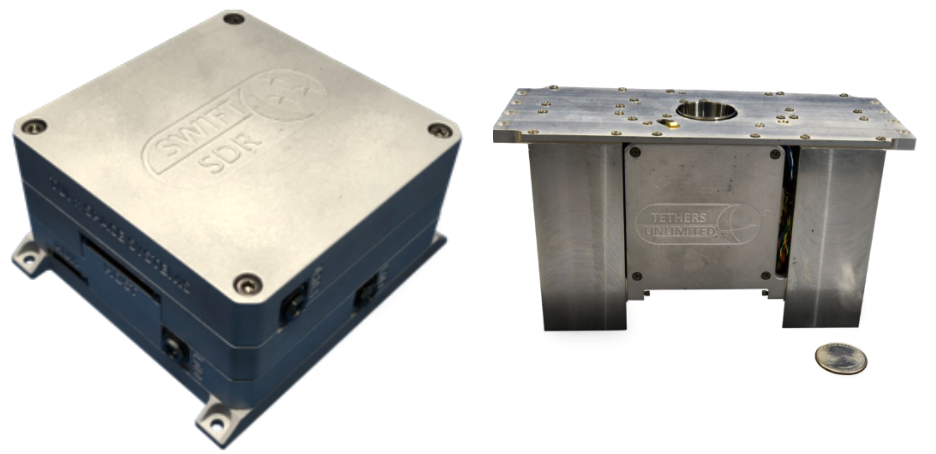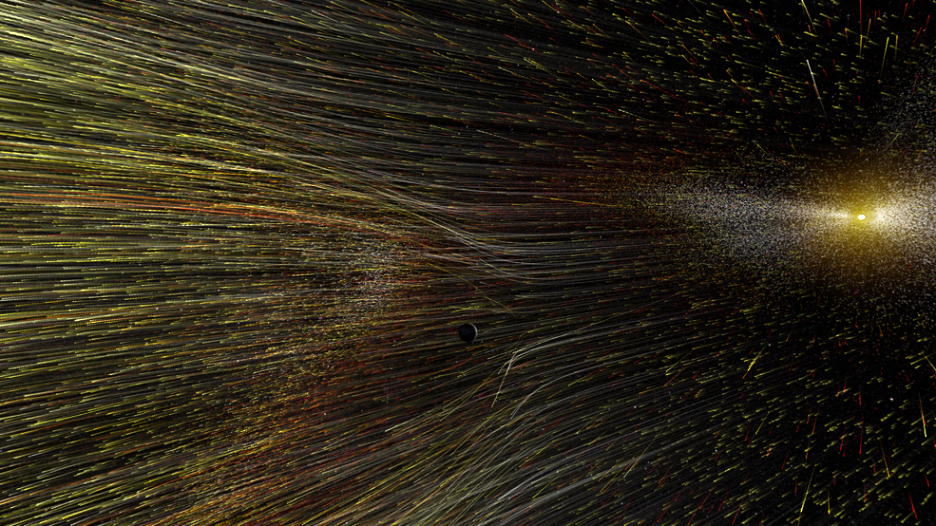
SWIFT-UTX UHF-Band Communications Transmitter (l),
HYDRO S-C™ (r).
Tethers Unlimited, Inc. (TUI) has announced the company has been contracted to provide key communications and propulsion capabilities to Southwest Research Institute (SwRI) in support of the NASA PUNCH Mission.
TUI will be delivering flight units of both its SWIFT®-XTS X-band software defined radio (SDR) and its HYDROS™-C water-electrolysis thruster.
The PUNCH mission will consist of a constellation of four smallsats that will launch as early as 2022 and they will orbit the Earth in formation to study how the Sun’s atmosphere, or corona, connects with the interplanetary medium. PUNCH will provide the first global images of how the solar corona infuses the solar wind with mass and energy.

A constant outflow of solar material streams out from the Sun, depicted here in an artist’s rendering. On June 20, 2019, NASA selected two new missions – the Polarimeter to Unify the Corona and Heliosphere (PUNCH) mission and Tandem Reconnection and Cusp Electrodynamics Reconnaissance Satellites (TRACERS) – to study the origins of this solar wind and how it affects Earth. Together, the missions support NASA’s mandate to protect astronauts and technology in space from such radiation.
Image credit: NASA
The SWIFT-XTS radio will be used for telemetry and control as well as main mission data downlink. The SWIFT-XTS radio is a compact and affordable S-band transceiver coupled with a high-speed X-band transmitter. Its “software defined” attributes make it readily configurable to support a wide range of mission needs, including in-flight adjustment of operating frequencies and modulations. The SWIFT software defined radios enable satellite operators to rapidly configure and tune their communications systems to maximize the amount of data they can deliver through the congested radio frequency spectrum.
TUI will also be providing an 8W X-band RF power amplifier for this program to enable the satellites to reliably close the communications link to ground stations from their distant orbits. The company’s SWIFT-XTS Software Defined Radio supports both reliable telemetry, tracking, and control (TT&C) and high-speed mission data delivery for small satellite missions.
The HYDROS-C is a shoebox-sized propulsion module that uses water as propellant. Unlike other water-based thrusters that simply expel heated steam, TUI’s HYDROS-C module first uses electrolysis to split water into its constituent elements, hydrogen and oxygen. The HYDROS-C module then burns the hydrogen and oxygen in a traditional bipropellant thruster. This water electrolysis method enables HYDROS to deliver better thrust efficiency than existing electric propulsion options and provides higher fuel economy than chemical thrusters. By using water, HYDROS-C is a truly “green propellant” solution that is safe for personnel during satellite integration as well as for primary payloads during launch. The availability of water on the moon and near-Earth asteroids makes HYDROS-C appealing as a refuellable propulsion option for future exploration architectures.
SwRI’s Dr. Craig DeForest, the PUNCH mission Principal Investigator, noted that procuring these complete spacecraft subsystems “off-the-rack” is critical to the PUNCH science. The growing commercial ecosystem for space enables a constellation of four, separate, high-capability spacecraft, within the cost of a single traditionally-built satellite.
Dr. Rob Hoyt, TUI’s President, said understanding how the sun drives the solar wind is critical to understanding how the sun influences space weather near the Earth as well as the fundamental processes that create solar systems. Tethers Unlimited will contribute the firm’s unique communications and propulsion technologies to enable these tiny spacecraft to accomplish such an important scientific mission.

Image is courtesy of NASA JPL.
